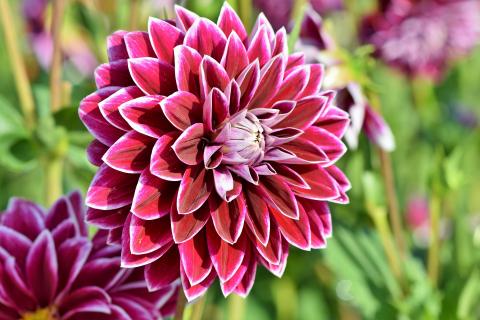In colder zones, lift your dahlias after the first frost! See our full guide on how to plant, grow, and care for these stunningly gorgeous, colorful flowers that bloom from midsummer through autumn, when many plants are past their best!
About Dahlias
Dahlia is a genus of tuberous plants that are members of the Asteraceae family; related species include the sunflower, daisy, chrysanthemum, and zinnia.
Picking a favorite dahlia is like going through a button box. As well as coming in a rainbow of colors, dahlia flowers can range in size from petite 2-inch lollipop-style pompoms to giant 15-inch “dinner plate” blooms. Most varieties grow 4 to 5 feet tall.
Dahlias love moist, moderate climates. Though not well suited to extremely hot climates (such as southern Florida or Texas), dahlias brighten up any sunny garden with a growing season that’s at least 120 days long.
The tubers are planted in the ground in late spring. They are considered a tender perennial in cold regions of North America. They are reliably winter hardy in hardiness zones 8 to 11, though gardeners in zones 6 and 7 may have luck keeping them in the ground as well. In more northern zones, dahlias can either be treated as annuals or dug up after the first frost and stored indoors for winter. (See what hardiness zone you’re in!)
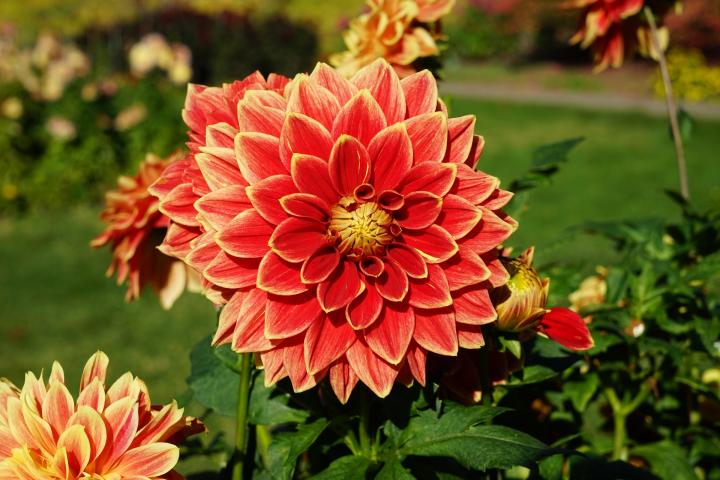
When to Plant Dahlias
- Don’t be in a hurry to plant; dahlias will struggle in cold soil. Ground temperature should reach 60°F. Wait until all danger of spring frost is past before planting. (We plant them a little after the tomato plants go in.)
- Some gardeners start tubers indoors in containers a month ahead to get a jump on the season. Medium to dwarf-size dahlias will do well in containers.
- Order dahlia tubers in early spring. This gives gardeners in colder zones time to get them growing in a sunny window. Or, skip the potting and simply plant the tubers in the ground after the spring weather has settled and the soil has warmed.
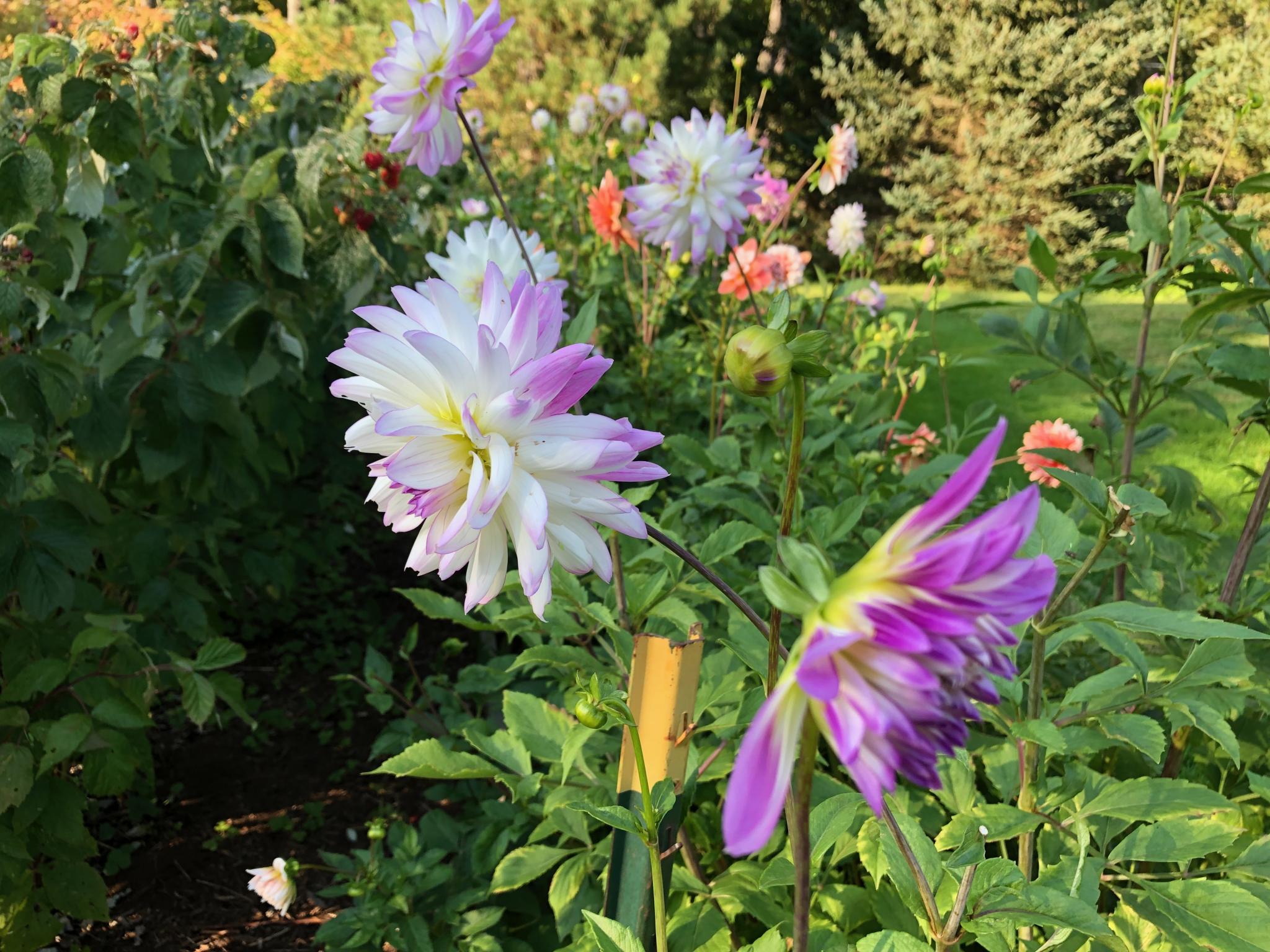
Choosing and Preparing a Planting Site
- Select a planting site with full sun. Dahlias grow more blooms with 6 to 8 hours of direct sunlight. They love the morning sunlight best. Choose a location with a bit of protection from the wind.
- Dahlias thrive in rich, well-drained soil. The pH level of your soil should be 6.5-7.0, slightly acidic.
- If you have a heavier (clay) soil, add in sand, peat moss, or aged manure to lighten and loosen the soil texture for better drainage.
- Large dahlias and those grown solely for cut flowers are best grown in a dedicated plot in rows on their own, free from competition from other plants. Dahlias of medium to low height mix well with other summer flowers. If you only have a vegetable garden, it’s the perfect place to put a row of dahlias for cutting (and something to look at while you’re weeding!).
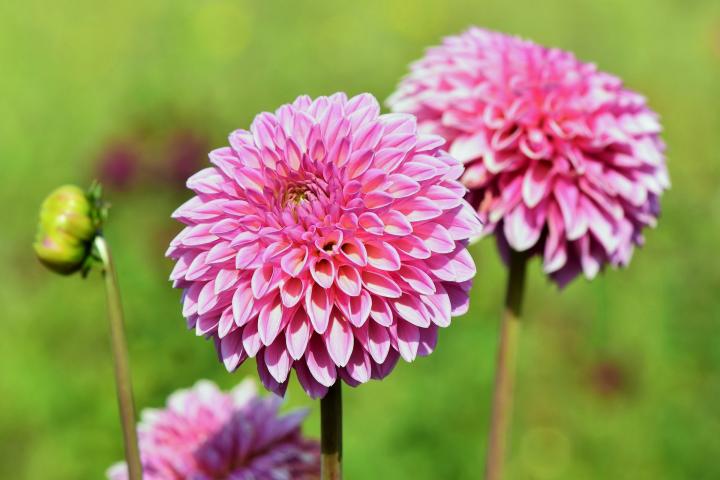
How to Plant Dahlias
- Avoid dahlia tubers that appear wrinkled or rotten. Pink “eyes” (buds) or a little bit of green growth are good signs. Don’t break or cut individual dahlia tubers as you would potatoes.
- Bedding dahlias can be planted 9 to 12 inches apart. The smaller flowering types, which are usually about 3 feet tall, should be spaced 2 feet apart. The taller, larger-flowered dahlias should be spaced 3 feet apart. If you plant dahlias about 1 foot apart, they make a nice flowering hedge and will support each other.
- The planting hole should be slightly larger than the root ball of the plant and incorporate some compost or sphagnum peat moss into the soil. It also helps to mix a handful of bonemeal into the planting hole. Otherwise, do not fertilize at planting.
- Dig a hole that’s about 6 to 8 inches deep. Set the tubers into it, with the growing points, or “eyes,” facing up, and cover with 2 to 3 inches of soil (some say 1 inch is adequate). As the stem sprouts, fill in with soil until it is at ground level.
- Tall, large-flowered cultivars will require support. Place stakes (five to six feet tall) around plants at planting time and tie stems to them as the plants grow.
- Dahlias start blooming about 8 weeks after planting, starting in mid-July.
- Do not water the tubers right after planting; this encourages rot. Wait until the sprouts have appeared above the soil to water.
- Do not bother mulching the plants. The mulch harbors slugs and dahlias like the sun on their roots.
Check out our video to learn more about growing dahlias in your garden.
How to Grow Dahlias
Watering
- There’s no need to water the soil until the dahlia plants appear; in fact, overwatering can cause tubers to rot. After dahlias are established, provide a deep watering 2 to 3 times a week for at least 30 minutes with a sprinkler (and more in dry, hot climates).
- Like many large-flower hybrid plants, the big dahlias may need extra attention before or after rain, when open blooms tend to fill up with water or take a beating from the wind.
Fertilizing
- Dahlias benefit from a low-nitrogen liquid fertilizer (similar to what you would use for vegetables) such as a 5-10-10 or 10-20-20. Fertilize after sprouting and then every 3 to 4 weeks from mid-summer until early Autumn. Do NOT overfertilize, especially with nitrogen, or you risk small/no blooms, weak tubers, or rot.
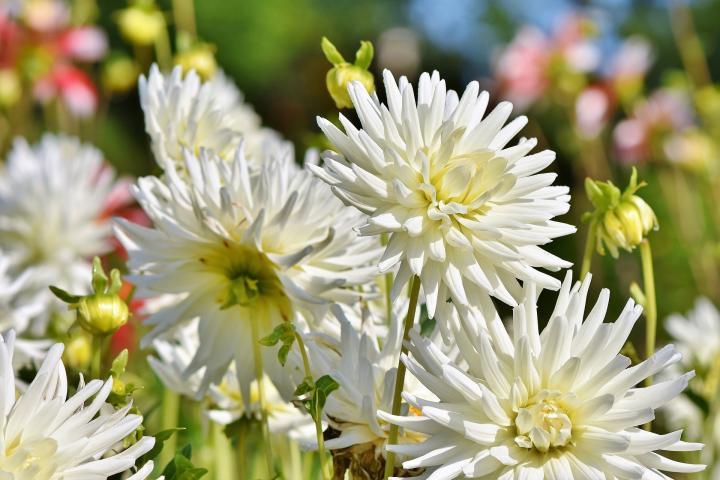
Pinching, Disbudding, and Staking
- When plants are about 1 foot tall, pinch out 3-4 inches of the growing center branch to encourage bushier plants and to increase stem count and stem length.
- If you want to grow large flowers try disbudding—removing the 2 smaller buds next to the central one in the flower cluster. This allows the plant to put all of its energy into fewer but considerably larger flowers.
- Bedding dahlias need no staking or disbudding; simply pinch out the growing point to encourage bushiness, and deadhead as the flowers fade. Pinch the center shoot just above the third set of leaves.
- For the taller dahlias, insert stakes at planting time. Moderately pinch, disbranch, and disbud, and deadhead to produce a showy display for 3 months or more.
Winter Care
- Dahlia foliage dies back with the first light frost in fall. Dahlias are reliably hardy in USDA Hardiness Zone 8 and warmer and can simply be cut back and left in the ground to overwinter; cover with a deep, dry mulch. Further north, the tuberous roots should be lifted and stored during the winter. (Some readers find, however, that dahlias will survive in Zone 7 or even Zone 6 if the winter isn’t too severe.) See Harvest/Storage (below) for more information.
- Slugs and snails: Bait 2 weeks after planting and continue to bait throughout the season.
- Mites: To avoid spider mites, spray beginning in late July and continue to spray through September. Speak to your garden center about recommended sprays for your area.
- Earwigs and Cucumber Beetle: They can eat the petals though they do not hurt the plant itself.
- Aphids
- Deer: Find a list of deer-resistant plants to grow around your dahlias.
- Powdery Mildew: This commonly shows up in the fall. You can preventatively spray before this issue arises from late July to August.
There are about 60,000 named varieties and 18 official flower forms including cactus, peony, anemone, stellar, collarette, and waterlily. The American Dahlia Society recognizes 15 different colors and color combinations. Here are some popular choices:
- ‘Bishop of Llandaff’: small, scarlet, intense flowers with handsome, dark-burgundy foliage
- ‘Miss Rose Fletcher’: an elegant, spiky, pink cactus plant with 6-inch globes of long, quilled, shell-pink petals
- ‘Bonne Esperance’, aka ‘Good Hope’: a foot-tall dwarf that bears 1-1/2-inch, rosy-pink flowers all summer that are reminiscent of Victorian bedding dahlias (though it debuted in 1948)
- ‘Kidd’s Climax’: the ultimate in irrational beauty with 10-inch “dinnerplate” flowers with hundreds of pink petals suffused with gold
- ‘Jersey’s Beauty’: a 7-foot tall pink plant with hand-size flowers that brings great energy to the fall garden.
Dahlia Bouquets
Dahlias are beautiful in a vase. Plus, the more you cut them the more they will bloom. To gather flowers for a bouquet, cut the stems in the morning before the heat of the day and put them into a bucket with cool water. Remove bottom leaves from the stems and place the dahlias in a vase. Put the vase in a cool spot and check the water daily. The bouquet should last about a week.
Digging and Storing Dahlias for Winter
Unless you live in a warmer region, you have to dig up dahlias in late fall. Native to Mexico, Dahlias won’t survive freezing temperatures. Digging and storing dahlias is extremely easy and simple, and will save you the money that would otherwise go into buying new ones each year.
If you live in an area where your ground doesn’t freeze, you don’t need to dig up your tubers. The general rule is: If you live in USDA Hardiness Zone 8 or warmer, you can leave dahlias in the ground. In Zone 6 or colder, dig them up. In Zone 7, you may be able to get away with just covering the plants with a thick layer of leaf or straw mulch, but if a deep freeze hits, you may lose them.
Find your USDA Hardiness Zone here.
When to Dig Up Tubers
Wait to dig up dahlia tubers until the top growth dies back or is killed by the first hard frost. See your fall frost dates for an idea of when frost usually arrives in your area.
Delay cutting dahlia stems until right before digging, because the stems are hollow and can collect water, which in turn promotes crown rot and tuber decay.
How to Dig Up Tubers
Digging up tubers is easy:
- Cut the stems down to 2 to 4 inches.
- Use a garden fork or a spade to loosen the soil around the entire plant. The “neck” on dahlia tubers is delicate and can be easily damaged while digging.
- Gently lift the tubers from the ground. Clean the soil from the tubers. Swish them around in a tub of water or use a garden hose to wash away any clumps of soil. Soil contains microorganisms that can cause decay in storage, so it’s best to remove as much as possible.
- The dahlia tubers then need to be allowed to dry and cure, but no more than a few days. Place the dahlias in a well-ventilated area with a constant temperature between 60°F and 70°F and out of direct sunlight.
Tuber clumps can either be left intact for the winter and divided in the spring, or they can be divided in the fall. Some gardeners find that it is easier to divide in the fall, and divisions are more convenient to store.
How to Store Dahlia Tubers
- You’ll need to keep tubers chilled (below 50℉ but above freezing).
- Place tubers inside plastic bags or cardboard boxes filled with material that maintains moisture around the tubers but allows air flow. Vermiculite, dry sand, Styrofoam peanuts, or wood shavings all work. Cover them with more storage medium before placing them in a cool storage spot.
Check on the dahlias occasionally over the winter. Remove any tubers that have started to rot before the decay spreads to healthy tubers.
Re-planting Tubers in Spring
- In the spring, remove the tubers from their storage containers, separate healthy tubers from the parent clump, and plant in the garden. Each tuber must have at least one “eye” or a piece of the crown attached or it will not develop into a blooming plant. The eyes are located at the base of the stem and look like little pink bumps.
See our gardener’s article on how to unpack and divide your stored dahlia tubers!
If this all seems like too much bother or you do not have the right storage place, skip digging and storing, and just start over by buying new tubers in the spring.
- The dahlia was named for Anders Dahl (Swedish botanist), born on March 17, 1751.
- In the 16th century, dahlias grew wild on the hillsides in parts of Mexico. There, they were “discovered” by the Spanish, who remarked on the plant’s beauty.
- Both dahlia flowers and tubers are edible. The tubers taste like a cross between a potato and a radish.
The Dahlia you brought to our isle
Your praises forever shall speak
‘Mid gardens as sweet as your smile
And colour as bright as your cheek.
–Lord Holland (1773–1840)

